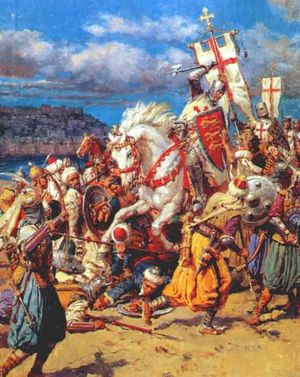Who is this St George anyway?
Given how his cross and flag are frequently used by the far right to protest against immigration and mosques, St George could not be any more of an immigrant if he tried.

England's patron saint is the epitome of a multi-cultural, diverse nation.
Here are some things you might not know about the so-called dragon slayer, including why we can't just have the day off on April 23:

1. St George is an immigrant.
His legend was brought to England from the Middle East during the crusades.
Whether he existed at all is open to debate. But it's generally believed that he would have been born in what is now Turkey to a Palestinian mother and a Turkish Roman father, both Christians.
Returning crusaders told how the saint had appeared and led them into battle at the siege of Antioch in 1098.
They then passed on the legend of how he allegedly slayed a dragon.
2. He was a thoroughly decent soul who spoke truth to power.
George was one of the best soldiers in the Roman army, according to the legend.
Then in about AD303 the Roman emperor Dicoletian declared that every Christian soldier should be arrested.
George thought this was wrong and asked the emperor to change his mind.
He was highly regarded by Diocletian who tried his best to persuade George he should worship Roman gods instead.
He offered him slaves, money and land, all of which George refused.
So Dicoletian had him tortured and executed.
He was lacerated on a wheel of swords then had his head cut off.
Before that though, George donated all his worldly goods to the poor.
3. He didn't really slay a dragon.
Sorry. But it's all a big misunderstanding.
The devil was portrayed as a dragon in mediaeval mythology.
The images of George were of him driving away evil spirits, with the dragon symbolising that.
The earliest versions of this story were from the 10th or 11th century where George was shown killing a monster in a lake in a town called Silene in Libya.
That story got into an encyclopedia called Speculum Historiale around the 13th century.
This sealed the story into the Christian tradition and has been associated with St George ever since.
4. St George was adopted as a patron saint by an English king.
King Edward III, who reigned from 1327 to 1377, liked the story of St George.
So he decided to make the St George Cross his military banner.
And after the flag was carried in the battle of Agincourt in 1415, Saint George's Day became a national feast day.
5. We don't make a big fuss about him.
St George's Day is not a bank holiday, although there have been plenty of petitions calling for it to be so.
Historian Diarmaid Macculloch suggested this apparent apathy was a consequence of the English Reformation and the separation of the Church of England from Rome under Henry VIII.
He said: "The English, being Protestants for nearly five centuries, have never had much time for saints' days - same with the Scots.
"Neither really need their patron saints to celebrate nationhood."
While the Welsh do very much celebrate St David's day, he suggests this is more to 'keep their end up against the English'.
6. We share St George with other countries.
The patron saint of England is also celebrated by Bosnia and Herzegovina, Bulgaria, Canada, Croatia, Cyprus, Georgia, Greece, Macedonia, Romania and Serbia.
7. We seem a bit uneasy about the flag.
For all the pride rightly felt about being English, there's something that makes us feel a bit awkward about the flag.
Maybe it's how it gets used by far right groups like the so-called English Defence League, who have turned up in Dudley to protest against a planned mosque.
Maybe it's the way England football fans don't always cover themselves in glory with their behaviour overseas.
And maybe it's because the English associate themselves more with the Union Flag than they do the plainer white and red of St George.
A survey by the think tank British Future in 2012 found 80 per cent of people linked the Union Flag to patriotism but only 61 per cent were the same about the English one.
The Scots and Welsh are far more likely to be patriotic about their flags.
8. We do it properly in the Black Country.
West Bromwich can lay claim to what is arguably the largest St George's Day parade in the country.
About 10,000 people gathered in Westminster Road, West Bromwich, for the start of the annual procession, which went for two miles from the Stone Cross starting point to Dartmouth Park on Sunday.
It has been going for around 18 years.
But in 2009 Sandwell Council controversially pulled support for the parade, going instead with a static party in the park, amid concerns it had been 'infiltrated' by the far right.
The organisers stressed it had not and went ahead anyway with financial help from businessman Chris Kelly in the form of a £10,000 donation. Today it remains an annual fixture, which the council promotes.
9. The flag was a battle emblem.
St George wore the red cross on his shield and banner.
Richard the Lionheart adopted it in the 12th century.
His soldiers wore it to distinguish themselves from their enemies in battle.
10. The legend has inspired bravery awards.
The highest award a civilian can earn is the George Cross, followed by the George Medal.
Both have the saint slaying a dragon on them.
That particular story may just be a myth. But the bravery of those honoured by his symbol is very real indeed.





